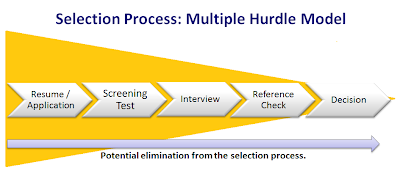What is a Competency?
Competencies are observable abilities, skills, knowledge, motivations or traits defined in terms of the behaviors needed for successful job performance.
Competency is a term that describes a pattern or cluster of actions taken to achieve a result.
It helps to understand the value of having a comprehensive picture of all the competencies needed for success within jobs by considering the iceberg as an analogy. While one can see the iceberg in the ocean, the majority of its bulk is hidden under water.
The whole “iceberg” represents the competencies needed for success in jobs. However, some factors (above the surface) are typically easier to identify and manage - for example, the skills, knowledge and experience of employees. Traits, motivations and self-concept, on the other hand, tend to be harder to identify and measure (below the surface). Skills, knowledge and experience are often the focus during hiring and selection; but, the other factors (below the surface), which are more intrinsic and difficult to identify and measure, are just as important for successful performance. Competencies provide a way of describing all success factors in terms of behaviors. These can then be measured and managed in the workplace.
Most organizations are fairly good at identifying technical skills, knowledge and experience required for jobs, but they are typically not as good at identifying those competencies like Initiative, Interactive Communication and Teamwork that can make the difference between highly successful versus not so successful performance in the workplace.
Why Competency-based Talent Management?
Competencies, and Competency-based Talent Management, translate the strategic visions and goals for the organization into behaviors or actions employees must display for the organization to be successful.
Benefits
- They translate the organization’s vision and goals into the behaviors employees are expected to display for the organization to be successful;
- They improve hiring and selection decisions because the competencies, which are used as the standards for assessment and selection, reflect the behaviors employees must have to be effective in their jobs and roles;
- They increase employee productivity and operational effectiveness, because they focus employees on the performance behaviors they need to display to be successful;
- They help in identifying employee strength areas for development that are directly linked to the organization’s strategic objectives;
- They help to shorten the learning curve for employees, by allowing both the organization and the employees to focus on those competencies that need development;
- They provide employees with an understanding of what is needed to be successful in their current and future roles, giving employees a sense of empowerment and control over their careers, thus increasing levels of job and career satisfaction and employee retention;
- Finally, they support strategic HR planning. Identifying the competencies needed to achieve the vision allows the organization to address gaps between the current skills and competencies of employees, and those needed in the desired future state. Plans can then be put into motion to ensure the organization has the talent needed to achieve its vision.
Sign up to our blog’s mailing list through the form on the right-hand side to receive the rest of the series in your inbox.
HRSG is a leader in competency-based talent management solutions. Contact us today to find out how we can help you.
Want to learn more? Competency-based Talent Management, or CbTM, is the best practice for defining job requirements and building effective HR programs to develop skilled, engaged and productive workforces. Download this Best Practice Guide to learn how competencies can increase workforce effectiveness and improve business practices.













